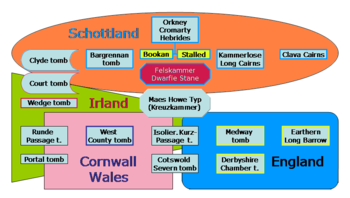
British megalith architecture is the study of those ancient cultures that built megalithic sites on the British Isles, including the research and documentation of these sites. The classification sometimes used of these cultures based on geological criteria is problematic.
The neolithic sites of Britain are amongst the most varied in the prehistory of Europe. Although (geologically) different from "megalithic" sites, the earthen long barrows in East England are grouped with them from a cultural historical perspective. The Medway tombs and the Derbyshire chamber tombs (Five Wells) occupy a special position as examples of megalithic sites in East England. The north–south boundary between earthen sites and stone sites in England and Scotland is crossed at three points to the east by the seven different types of megalith site types (in the so-called mixed regions).
The activities of megalithic cultures in the region dates back to prehistoric times. There are many parallels between the prehistoric architecture of Ireland and the now British regions of Cornwall (including the Isles of Scilly), the Isle of Man, Wales and Scotland; but there are somewhat greater differences between those and the sites in England and, particularly, the Channel Islands. Although almost all regions have endemic megalith types, but they also usually have unique examples (e.g. the chamber tomb of Glyn) as well as forms that they share with one or two neighbouring regions.
Exemplary in this respect are the "cruciform passage" sites of the Maes Howe type in Orkney (in Ireland e.g. Knowth and Newgrange), whose distribution extends as far as the Scilly Isles and Devonshire in England. In addition to the great wealth of variety in Scotland, favoured by its geography, there are also sites on the Scottish islands with individual characteristics.
Neolithic monuments are an expression of the culture and ideology of Neolithic societies. Their origin and function are considered characteristic of social development.[1]
- ^ J. Müller In: Varia neolithica VI 2009 p. 15